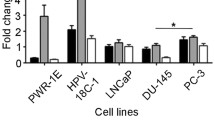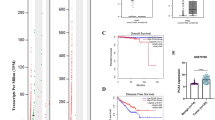Abstract
MicroRNAs (miRNAs) are endogenous noncoding RNAs that down-regulate gene expression by promoting cleavage or translational arrest of target mRNAs. While most miRNAs are transcribed from their own dedicated genes, some map to introns of ‘host’ transcripts, the biological significance of which remains unknown. Here, we show that prostate cells are naturally devoid of EGF-like domain 7 (Egfl7) transcripts and hence also deficient in a miRNA, miR-126*, generated from splicing and processing of its ninth intron. Use of recombinant and synthetic miRNAs or a specific antagomir established a role of miR-126* in silencing prostein in non-endothelial cells. We mapped two miR-126*-binding sites in the 3′UTR of the prostein mRNA required for translational repression. Transfection of synthetic miR-126* into prostate cancer LNCaP cells strongly reduced the translation of prostein. Interestingly, loss of prostein correlated with reduction of LNCaP cell migration and invasion. Thus, the robust expression of prostein protein in the prostate cells results from a combination of transcriptional activation of the prostein gene and absence of intronic miRNA-126* due to the prostate-specific repression of the Egfl7 gene. We conclude that intronic miRNAs from tissue-specific transcripts, or their natural absence, make cardinal contributions to cellular gene expression and phenotype. These findings also open the door to tissue-specific miRNA therapy.






Similar content being viewed by others
Abbreviations
- bp:
-
base pair
- RNAi:
-
RNA interference
- siRNA:
-
small interfering RNA
- miRNA:
-
microRNA
- RISC:
-
RNAi-induced silencing complex
- RSV:
-
respiratory syncytial virus
- UTR:
-
untranslated region
- (Egfl7):
-
EGF-like domain 7
- GAPDH:
-
glyceraldehyde 3-phosphate dehydrogenase
- HUVEC:
-
human umbilical vein endothelial cells
References
Fire A, Xu S, Montgomery MK, Kostas SA, Driver SE, Mello CC (1998) Potent and specific genetic interference by double-stranded RNA in Caenorhabditis elegans. Nature 391:806–811
Barik S (2005) Silence of the transcripts: RNA interference in medicine. J Mol Med 83:764–773
Ambros V (2004) The functions of animal microRNAs. Nature 431:350–355
Bartel DP (2004) MicroRNAs: genomics, biogenesis, mechanism, and function. Cell 116:281–297
Pillai RS, Bhattacharyya SN, Filipowicz W (2007) Repression of protein synthesis by miRNAs: how many mechanisms? Trends Cell Biol 17:118–126
Brennecke J, Stark A, Russell RB, Cohen SM (2005) Principles of microRNA-target recognition. PLoS Biol 3:e85
Lewis BP, Burge CB, Bartel DP (2005) Conserved seed pairing, often flanked by adenosines, indicates that thousands of human genes are microRNA targets. Cell 120:15–20
Grimson A, Farh KK, Johnston WK, Garrett-Engele P, Lim LP, Bartel DP (2007) MicroRNA targeting specificity in mammals: determinants beyond seed pairing. Mol Cell 27:91–105
Kiriakidou M, Nelson PT, Kouranov A, Fitziev P, Bouyioukos C, Mourelatos Z, Hatzigeorgiou A (2004) A combined computational-experimental approach predicts human microRNA targets. Genes Dev 18:1165–1178
Lim LP, Lau NC, Garrett-Engele P, Grimson A, Schelter JM, Castle J, Bartel DP, Linsley PS, Johnson JM (2005) Microarray analysis shows that some microRNAs downregulate large numbers of target mRNAs. Nature 433:769–773
John B, Enright AJ, Aravin A, Tuschl T, Sander C, Marks DS (2004) Human microRNA targets. PLoS Biol 2:e363. Erratum in: PLoS Biol (2005) 3:e264
Griffiths-Jones S, Grocock RJ, van Dongen S, Bateman A, Enright AJ (2006) miRBase: microRNA sequences, targets and gene nomenclature. Nucleic Acids Res 34:D140–D144
Lagos-Quintana M, Rauhut R, Yalcin A, Meyer J, Lendeckel W, Tuschl T (2002) Identification of tissue-specific microRNAs from mouse. Curr Biol 12:735–739
Baskerville S, Bartel DP (2005) Microarray profiling of microRNAs reveals frequent coexpression with neighboring miRNAs and host genes. RNA 11:241–247
Sood P, Krek A, Zavolan M, Macino G, Rajewsky N (2006) Cell-type-specific signatures of microRNAs on target mRNA expression. Proc Natl Acad Sci USA 103:2746–2751
Landgraf P (2007) A mammalian microRNA expression atlas based on small RNA library sequencing. Cell 129:1401–1414
Kim VN, Nam JW (2006) Genomics of microRNA. Trends Genet 22:165–173
Kim VN (2005) MicroRNA biogenesis: coordinated cropping and dicing. Nat Rev Mol Cell Biol 6:376–385
Rodriguez A, Griffiths-Jones S, Ashurst JL, Bradley A (2004) Identification of mammalian microRNA host genes and transcription units. Genome Res 14:1902–1910
Ying SY, Lin SL (2004) Intron-derived microRNAs—fine tuning of gene functions. Gene 342:25–28
Weber MJ (2005) New human and mouse microRNA genes found by homology search. FEBS J 272:59–73
Lin SL, Miller JD, Ying SY (2006) Intronic microRNA (miRNA). J Biomed Biotechnol 2006:26818
Kim YK, Kim VN (2007) Processing of intronic microRNAs. EMBO J 26:775–783
Soncin F, Mattot V, Lionneton F, Spruyt N, Lepretre F, Begue A, Stehelin D (2003) VE-statin, an endothelial repressor of smooth muscle cell migration. EMBO J 22:5700–5711
Parker LH, Schmidt M, Jin SW, Gray AM, Beis D, Pham T, Frantz G, Palmieri S, Hillan K, Stainier DY, De Sauvage FJ, Ye W (2004) The endothelial-cell-derived secreted factor Egfl7 regulates vascular tube formation. Nature 428:754–758
Fitch MJ, Campagnolo L, Kuhnert F, Stuhlmann H (2004) EGFL7, a novel epidermal growth factor-domain gene expressed in endothelial cells. Dev Dyn 230:316–324
Campagnolo L, Leahy A, Chitnis S, Koschnick S, Fitch MJ, Fallon JT, Loskutoff D, Taubman MB, Stuhlmann H (2005) EGFL7 is a chemoattractant for endothelial cells and is up-regulated in angiogenesis and arterial injury. Am J Pathol 167:275–284
Porkka KP, Pfeiffer MJ, Waltering KK, Vessella RL, Tammela TL, Visakorpi T (2007) MicroRNA expression profiling in prostate cancer. Cancer Res 67:6130–6135
Cunha AC, Weigle B, Kiessling A, Bachmann M, Rieber EP (2006) Tissue-specificity of prostate specific antigens: comparative analysis of transcript levels in prostate and non-prostatic tissues. Cancer Lett 236:229–238
Xu J, Kalos M, Stolk JA, Zasloff EJ, Zhang X, Houghton RL, Filho AM, Nolasco M, Badaro R, Reed SG (2001) Identification and characterization of prostein, a novel prostate-specific protein. Cancer Res 61:1563–1568
Krutzfeldt J, Rajewsky N, Braich R, Rajeev KG, Tuschl T, Manoharan M, Stoffel M (2005) Silencing of microRNAs in vivo with ‘antagomirs'. Nature 438:685–689
Niwa H, Yamamura K, Miyazaki J (1991) Efficient selection for high-expression transfectants with a novel eukaryotic vector. Gene 108:193–199
Schwarz DS, Hutvagner G, Du T, Xu Z, Aronin N, Zamore PD (2003) Asymmetry in the assembly of the RNAi enzyme complex. Cell 115:199–208
Khvorova A, Reynolds A, Jayasena SD (2003) Functional siRNAs and miRNAs exhibit strand bias. Cell 115:209–216. Cell Erratum in:505
Bitko V, Musiyenko A, Shulyayeva O, Barik S (2004) Inhibition of respiratory viruses by nasally administered siRNA. Nat Med 11:50–55
Bitko V, Garmon NE, Cao T, Estrada B, Oakes JE, Lausch RN, Barik S (2004) Activation of cytokines and NF-kappa B in corneal epithelial cells infected by respiratory syncytial virus: potential relevance in ocular inflammation and respiratory infection. BMC Microbiol 4:28
Elbashir SM, Harborth J, Lendeckel W, Yalcin A, Weber K, Tuschl T (2001) Duplexes of 21-nucleotide RNAs mediate RNA interference in cultured mammalian cells. Nature 411:494–498
Bitko V, Barik S (2001) Phenotypic silencing of cytoplasmic genes using sequence-specific double-stranded short interfering RNA and its application in the reverse genetics of wild type negative-strand RNA viruses. BMC Microbiol 1:34
Burke E, Dupuy L, Wall C, Barik S (1998) Role of cellular actin in the gene expression and morphogenesis of human respiratory syncytial virus. Virology 252:137–148
Krek A, Grun D, Poy MN, Wolf R, Rosenberg L, Epstein EJ, MacMenamin P, da Piedade I, Gunsalus KC, Stoffel M, Rajewsky N (2005) Combinatorial microRNA target predictions. Nat Genet 37:495–500
Naora H, Deacon NJ (1982) Relationship between the total size of exons and introns in protein-coding genes of higher eukaryotes. Proc Natl Acad Sci USA 79:6196–6200
Clement JQ, Qian L, Kaplinsky N, Wilkinson MF (1999) The stability and fate of a spliced intron from vertebrate cells. RNA 5:206–220
Pillai RS, Artus CG, Filipowicz W (2004) Tethering of human Ago proteins to mRNA mimics the miRNA-mediated repression of protein synthesis. RNA 10:1518–1525
Kalos M, Askaa J, Hylander BL, Repasky EA, Cai F, Vedvick T, Reed SG, Wright GL Jr., Fanger GR (2004) Prostein expression is highly restricted to normal and malignant prostate tissues. The Prostate 60:246–256
Trent JM, Stanbridge EJ, McBride HL, Meese EU, Casey G, Araujo DE, Witkowski CM, Nagle RB (1990) Tumorigenicity in human melanoma cell lines controlled by introduction of human chromosome 6. Science 247:568–571
Ray ME, Su YA, Meltzer PS, Trent JM (1996) Isolation and characterization of genes associated with chromosome-6 mediated tumor suppression in human malignant melanoma. Oncogene 12:2527–2533
Acknowledgments
This work was supported in part by the US National Institute of Health (NIH) grant AI059267 to S.B. We thank Dr. Ratna Chakrabarti (University of Central Florida) for the LNCaP cells, Dr. Lalita Shevde-Samant (Mitchell Cancer Institute) for the PC3 and DU145 cell lines and advice with the Boyden chamber and wounding assays, Dr. Ramesh Pillai (EMBL Grenoble, France) for the pRL-Con plasmid, and Dr. Lance Ford (Bioo Scientific Corp., Austin, Texas) for helpful discussions on miRNA analysis and assay.
Author information
Authors and Affiliations
Corresponding author
Rights and permissions
About this article
Cite this article
Musiyenko, A., Bitko, V. & Barik, S. Ectopic expression of miR-126*, an intronic product of the vascular endothelial EGF-like 7 gene, regulates prostein translation and invasiveness of prostate cancer LNCaP cells. J Mol Med 86, 313–322 (2008). https://doi.org/10.1007/s00109-007-0296-9
Received:
Revised:
Accepted:
Published:
Issue Date:
DOI: https://doi.org/10.1007/s00109-007-0296-9




